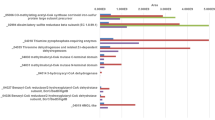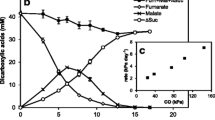Abstract
Phenyl methyl ethers are utilized by Desulfitobacterium hafniense DCB2 and Desulfitobacterium hafniense PCE-S; the methyl group derived from the O-demethylation of these substrates can be used as electron donor for anaerobic fumarate respiration or dehalorespiration. The activity of all enzymes involved in the oxidation of the methyl group to carbon dioxide via the acetyl-CoA pathway was detected in cell extracts of both strains. In addition, a carbon monoxide dehydrogenase activity could be detected. Activity staining of this enzyme indicated that the enzyme is a bifunctional CO dehydrogenase/acetyl-CoA synthase.



Similar content being viewed by others
References
Bache R, Pfennig N (1981) Selective isolation of Acetobacterium woodii on methoxylated aromatic acids and determination of growth yields. Arch Microbiol 130:255–261
Bergmeyer HU, Graßl M, Walter HE (1983) Acetate kinase. In: Bergmeyer HU (ed) Methods of enzymatic analysis, vol 2, 3rd edn. Verlag Chemie, Weinheim, pp 127–128
Beutler HO (1988) Determination with acetyl-CoA synthetase. In: Bergmeyer HU (ed) Methods of enzymatic analysis, vol 6, 3rd edn. VCH Publishers Ltd, Cambridge, pp 639–645
Bonam D, Murrell SA, Ludden PW (1984) Carbon monoxide dehydrogenase from Rhodospirillum rubrum. J Bacteriol 159:693–699
Bradford MM (1976) A rapid and sensitive method for the quantification of microgram quantities of protein utilising the principle of protein dye binding. Anal Biochem 72:248–254
Clark JE, Ragsdale SW, Ljungdahl LG, Wiegel J (1982) Levels of enzymes involved in the synthesis of acetate from CO2 in Clostridium thermoautotrophicum. J Bacteriol 151:507–509
Daniel SL, Keith ES, Yang H, Lin YS, Drake HL (1991) Utilization of methoxylated aromatic compounds by the acetogen Clostridium thermoaceticum : expression and specificity of the CO dependent O-demethylating activity. Biochem Biophys Res Comm 180:416–422
Dennie D, Gladu I, Lépine F, Villemur R, Bisaillon JG, Beaudet R (1998) Spectrum of the reductive dehalogenation activity of Desulfitobacterium frappieri PCP-1. Appl Environ Microbiol 64:4603–4606
Diekert G (1992) The acetogenic bacteria. In: Balows A, Trüper HG, Dworkin M, Harder W, Schleifer KH (eds) The prokaryotes, 2nd edn. Springer, Heidelberg
Diekert G, Thauer RK (1978) Carbon monoxide oxidation by Clostridium thermoaceticum and Clostridium formicoaceticum. J Bacteriol 136:597–606
Jeon WB, Cheng J, Ludden PW (2001) Purification and characterization of membrane-associated CooC protein and its functional role in the insertion of nickel into carbon monoxide dehydrogenase from Rhodospirillum rubrum. J Biol Chem 276:38602–38609
Kaufmann F, Wohlfarth G, Diekert G (1997) Isolation of O-demethylase, an ether-cleaving enzyme system of the homoacetogenic strain MC. Arch Microbiol 168:136–142
Kaufmann F, Wohlfarth G, Diekert G (1998) O-demethylase from Acetobacterium dehalogenans: cloning, sequencing, and active expression of the gene encoding the corrinoid protein. Eur J Biochem 257:515–521
Ljungdahl LG, Andreesen JR (1978) Formate dehydrogenase, a selenium-tungsten enzyme from Clostridium thermoaceticum. In: McCormick DB, Wright LD (eds) Methods in enzymology, vol 53. Academic Press, New York, pp 360–372
Ma K, Wohlfarth G, Diekert G (1991) Acetate formation from CO and CO2 by cell extracts of Peptostreptococcus productus (strain Marburg). Arch Microbiol 156:75–80
Meßmer M, Wohlfarth G, Diekert G (1993) Methyl chloride metabolism of the strictly anaerobic, methyl chloride-utilizing homoacetogen strain MC. Arch Microbiol 160:383–387
Milliken CE, Meier GP, Watts JEM, Sowers KR, May HD (2004) Microbial anaerobic demethylation and dechlorination of chlorinated hydroquinone metabolites synthesized by basidiomycete fungi. Appl Environ Microbiol 70:385–392
Neumann A, Engelmann T, Schmitz R, Greiser Y, Orthaus A, Diekert G (2004) Phenyl methyl ethers: novel electron donors for respiratory growth of Desulfitobacterium hafniense and Desulfitobacterium sp. strain PCE-S. Arch Microbiol 181:245–249
Nonaka H, Keresztes G, Shinoda Y, Ikenaga Y, Abe M, Naito K, Inatomi K, Furukawa K, Inui M, Yukawa H (2006) Complete genome sequence of the dehalorespiring bacterium Desulfitobacterium hafniense Y51 and comparison with Dehalococcoides ethenogenes 195. J Bacteriol 188:2262–2274
Rabinowitz JC, Pricer WE (1962) Formytetrahydrofolate synthetase: isolation and crystallization of the enzyme. J Biol Chem 237:2898–2902
Ragsdale S, Kumar M (1996) Nickel-containing carbon monoxide dehydrogenase/acetyl-CoA synthase. Chem Rev 96:2515–2539
Ragsdale SW, Ljungdahl LG (1984) Hydrogenase from Acetobacterium woodii. Arch Microbiol 139:361–365
Schauder R, Preuß A, Jetten M, Fuchs G (1989) Oxidative and reductive acetyl CoA/carbon monoxide dehydrogenase pathway in Desulfobacterium autotrophicum. 2. Demonstration of the enzymes of the pathway and comparison of CO dehydrogenase. Arch Microbiol 151:84–89
Siebert A, Schubert T, Engelmann T, Studenik S, Diekert G (2005) Veratrole-O-demethylase of Acetobacterium dehalogenans: ATP dependent reduction of the corrinoid protein. Arch Microbiol 183:378–384
Traunecker J, Preuß A, Diekert G (1991) Isolation and characterization of a methyl chloride utilizing, strictly anaerobic bacterium. Arch Microbiol 156:416–421
Tsukatani T, Matsumoto K (2000) Flow-injection fluorometric quantification of succinate in foodstuffs based on the use of an immobilized enzyme reactor. Anal Chem Acta 416:197–203
Uyeda K, Rabinowitz JC (1967) Enzymes of clostridial purine fermentation. Methylene tetrahydrofolate dehydrogenase. J Biol Chem 242:4378–4385
Wohlfarth G, Buckel W (1985) A sodium ion gradient as energy source for Peptostreptococcus asaccharolyticus. Arch Microbiol 142:128–135
Wohlfarth G, Geerligs G, Diekert G (1990) Purification and characterization of NADP+-dependent 5, 10-methylentetrahydrofolate dehydrogenase from Peptostreptococcus productus Marburg. J Bacteriol 173:1414–1419
Wood HG, Ljungdahl LG (1991) Autotrophic character of acetogenic bacteria. In: Shively JM, Barton LL (eds) Variations in autotrophic life. Academic Press, San Diego, pp 201–250
Wu Z, Daniel SL, Drake H (1988) Characterization of a CO-dependent O-demethylating enzyme system from the acetogen Clostridium thermoaceticum. J Bacteriol 170:5747–5750
Xia J, Lindahl P (1995) Decomposition of carbon monoxide dehydrogenase into α metallosubunits and a catalytically-active form consisting primarily of β metallosubunits. Biochemistry 34:6037–6042
Xia J, Sinclair J, Baldwin T, Lindahl P (1996) Carbon monoxide dehydrogenase from Clostridium thermoacetium: quaternary structure, stoichiometry of its SDS-induced dissociation, and characterization of the faster-migrating form. Biochemistry 35:1965–1971
Acknowledgments
This work was supported by a grant from the Deutsche Forschungsgemeinschaft (DFG). We would also like to express our gratitude to Yvonne Greiser for her skillful technical assistance.
Author information
Authors and Affiliations
Corresponding author
Additional information
Communicated by Gregory Cook.
Rights and permissions
About this article
Cite this article
Kreher, S., Schilhabel, A. & Diekert, G. Enzymes involved in the anoxic utilization of phenyl methyl ethers by Desulfitobacterium hafniense DCB2 and Desulfitobacterium hafniense PCE-S. Arch Microbiol 190, 489–495 (2008). https://doi.org/10.1007/s00203-008-0400-8
Received:
Revised:
Accepted:
Published:
Issue Date:
DOI: https://doi.org/10.1007/s00203-008-0400-8




